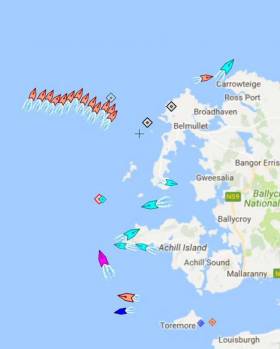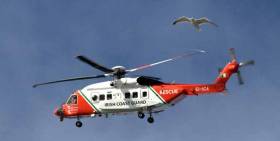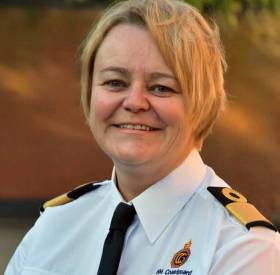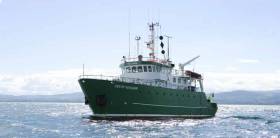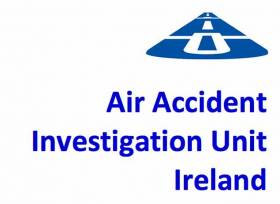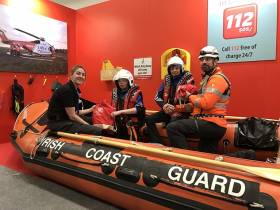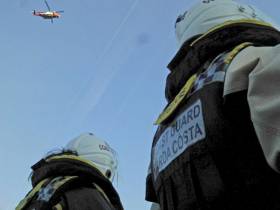Displaying items by tag: Coast Guard
Killybegs Coast Guard RIB Takes Dive Boat Under Tow
The volunteer crew of Bundoran RNLI Lifeboat were requested to launch this afternoon to assist a dive boat with 4 persons on board, which had broken down.
The alarm was raised around 1:50pm with Malin Head Coast Guard who immediately requested the launch of the Bundoran Lifeboat and also tasked the Killybegs Coast Guard RIB.
The Bundoran Lifeboat launched at 2pm to the dive boat which was around a mile north of Bullockmore, (west of St John’s Point). The Killybegs Coast Guard rib took the dive boat under tow to Killybegs Harbour with the Bundoran Lifeboat accompanying both vessels.
On returning to the station around 90 minutes later, Volunteer Lifeboat Crew member with Bundoran RNLI Richard Gillespie said ‘the people on board the dive boat were absolutely correct to call the Coast Guard and have ourselves and Killybegs launched. While they were in no immediate danger, the longer they left the call, the more chances there were of something going wrong. We would always encourage boat users to contact the Coast Guard on the first sign of a problem so we can be there to help sooner rather than later.’
Hoax Calls To Rescue Services Put Lives at Risk
The Bangor and Donaghadee RNLI lifeboats launched last week following a ‘Mayday’ call. It was a hoax. Someone decided to make a false call and those two lifeboat crews in Northern Ireland started a search for what was reported to be “a kayaker in trouble… “ Afloat's report of the incident is here.
A rescue helicopter was also called in from Prestwick in Scotland… A search was carried out and the Coast Guard established the call as “an elaborate hoax..”
Bearing in mind the tragedy of Irish Coast Guard helicopter R116 and with the search for two of that crew still continuing, the hoax call-out which resulted in Bangor and Donaghadee lifeboats being launched and the Prestwick helicopter called in from Scotland, was shocking…. So on my Podcast this week I highlight the serious dangers caused by hoax call-outs.
Listen to the Podcast here and the response of the RNLI.
Fishing Boats Join Search For #Rescue116 Crew in Largest Open Water Search in History of the State
The Coast Guard Rescue Coordination Centre in Malin is managing the surface search for the two missing crewmen of Rescue 116 this morning with a reported large number of fishing vessels that have offered their services.
The search is being desrcibed as the 'Largest open water search in the history of the Irish State'. Calm conditions off the West Coast have enabled searchers to get underway as planned.
No trace of Paul Ormsby or Ciarán Smith was found when the wreck of the Sikorsky S-92 helicopter was lifted from the sea bed off Black Rock in Co Mayo last weekend, as previously reported on Afloat.ie.
While underwater operations are ongoing, a fleet of fishing vessels from Killybegs this week are sweeping the Atlantic seaboard at first light this morning for any sign of the missing coastguard airmen.
More on this in our post yesterday here
Search Continues for Missing Crew of R116
Remote Operations Vehicle (ROV) operations, conducted by Marine Institute specialists on-board the Granuaile in conjunction with An Garda Síochána and the Air Accident Investigation Unit continued overnight and are ongoing. Wind has freshened overnight, which may constrain certain elements of the proposed search until Sunday, but conditions remain favourable for time being. Air, surface and shoreline searches are ongoing today, supported by Coast Guard, RNLI and Civil Defence volunteers. The Shannon based Coast Guard helicopter will conduct aerial searches later today. The Air Corps are also supporting the search.
Also the Coast Guard wishes to request all mariners, particularly those not participating on Saturday 8th April, to continue to keep a good lookout for any material associated with R116 and report any sightings to Malin Head Coast Guard Co-ordination Centre.
The Maritime & Coastguard Agency’s new Head of Maritime Operations, Julie-Anne Wood, has made history by becoming the first woman to achieve this rank in the history of Her Majesty’s Coastguard.
The role of Head of Maritime Operations heads up the National Maritime Operations Centre in Fareham and the 10 Coastguard Operations Centres that co-ordinate search and rescue around the UK coast. It is one of the most senior roles in HM Coastguard, part of the Maritime & Coastguard Agency, and up until now, the role has always been held by a man.
Julie-Anne Wood began her Coastguard career in the Welsh coastal town of Milford Haven in 1999 as a part-time Coastguard Watch Assistant. Before that, she ran her own business providing safety training to fishermen and merchant seamen in Wales. An opportunity for a permanent Coastguard Watch Assistant came up and in Julie-Anne’s words, she ‘never looked back’.
Over the next nine years, Julie-Anne progressed through the ranks to Watch Officer, Watch Manager and then Rescue Co-ordination Centre Manager in 2008. In 2011, her career changed direction, where she fulfilled her long-term goal to become a Coastguard Technical Trainer within the HR team. In 2013, she became head of Technical Training and Standards and in 2014 she temporarily covered the role of Head of Maritime Operations. In January 2017, she was appointed to the position permanently.
Julie-Anne says she didn’t set out to make HM Coastguard history. It was just a natural advancement of her career. ‘It’s a huge responsibility and a position that I’m very honoured to hold. What may have once been a male-dominated industry is very different these days. The Maritime & Coastguard Agency has incorporated women in everything they do. In my experience, there have been no restrictions. I have never allowed my gender to get in the way of my career – that’s one of the great things about HM Coastguard – the only limits on women are those that are imposed by themselves.
‘I am fortunate to be surrounded by an extraordinary team of strong women and men who are driven, talented and deliver an incredible service 24 hours a day.'
Despite her success, Julie-Anne has said that her proudest moments are still engrained in bringing people home to their families. ‘Every rescue is different, but the feeling you get when we’ve rescued someone in their darkest hours still makes a huge impression on me emotionally. There is no better feeling than seeing families reunited and know that you’ve played a part in that.’
The AAIU in consultation with An Garda Síochána, the Navy, the Coast Guard, the GSI and the Marine Institute wish to advise that following initial Remote Operated Vehicle (ROV) operations the wreckage of R116 has been positively located on the sea bed on the Eastern side of Black Rock, at a depth of approx. 40m.
Operations are continuing but are weather dependent.
AAIU Statement on Investigation into the Loss of R116
The AAIU wishes to extend its sincere sympathies to the families and friends of the crew of R116.
The Chief Inspector of Air Accidents, Mr. Jurgen Whyte, in consultation with the appointed Investigator-in-Charge, Mr. Paul Farrell, wishes to make the following statement.
An AAIU investigation into the circumstances of the loss of R116 is underway. As with all AAIU investigations, this Investigation will be evidence based.
The Investigation has been working with the Garda Síochána, Coast Guard, Irish Air Corps, the Irish Marine Institute, and many local persons and agencies with the primary objective of locating and recovering the missing crew members.
In addition, the AAIU is anxious to recover and examine as much wreckage as possible, and in particular to recover the combined voice and flight data recorder (“black box”). The AAIU, in accordance with international convention, has an Accredited Representative from the US National Transportation Safety Board (as state of design and manufacture); that representative has advisers from the US Federal Aviation Administration and the aircraft manufacturer. The AAIU has also received assistance, support and advice from the UK Air Accidents Investigation Branch two of whose inspectors attended Blacksod.
A significant amount of wreckage has been recovered from the sea and this has been logged and will be brought to the AAIU wreckage facility in Gormanston, Co Meath, for detailed examination.
Furthermore, the AAIU has visited Black Rock Light House, on the approaches to Blacksod bay, which is close to the last recorded position of the helicopter. Some helicopter wreckage has been recovered from the general area of Black Rock Light House. This wreckage is primarily from the tail area of the helicopter. At this early stage in the investigation it is not possible to be definitive about the exact nature of damage to the recovered wreckage or indeed the circumstances of the accident. However, there appears to be marks on some of the recovered wreckage which are consistent with the tail of the aircraft contacting rocky surfaces on the Western end of Blackrock.
The Investigation has not yet definitively identified the initial point of impact.
Equipment aboard surface search vessels has detected a signal which is believed to be from the underwater locator beacon attached to the aircraft’s “Black Box”. This signal points toward an area which will be the focus of further, multi-agency investigation activities at the earliest opportunity, subject to weather.
Coast Guard 'Emergency Challenge' At Young Scientist Exhibition
The Irish Coast Guard is well represented at this week's BT Young Scientist Exhibition where 60,000 visitors are expected to attend.
The six Coast Guard stations in attendance at the RDS, Dublin are distributing wristbands, pencils and competition flyers as well as staging today's 'Emergency Challenge' competition.
EPIRBs Responsible For Directly Saving Lives of Five Mariners – Coast Guard End of Year Statement
Use of Personal Locator Beacons (PLBs) and Electronic Position Indicating Radio Beacons (EPIRBs) were responsible for directly saving the lives of Five Mariners in 2016 according to an end of year commentary by the Coast Guard. One of these incidents related to a Coast Guard helicopter rescue of a lone yachtsman, whose yacht had overturned, 20 miles south of Co Wexford. A second related to the location and recovery of three fishermen whose vessel had sunk. The third incident concerned the location of a single crewed yacht which had become dis-masted off the SW Coast and was subsequently towed to Castletownbere, Co Cork.
Overall the Coast Guard coordinated some 2500 incidents through its three Marine Rescue Coordination Centres based in Valentia, Malin and its Dublin Head Quarters. A total of 405 people who were rescued or assisted were categorised as ‘lives saved’ on the basis that the intervention precluded loss of life or severe risk of loss of life. The Coast Guard noted an increase in kayaking and surfing related incidents with a total of 45 individual incidents requiring a response being recorded. Coast Guard units and helicopters assisted with the recovery of forty five (45) bodies as a result of drowning and other missing person searches.
The tragic loss of Volunteer Caitríona Lucas cast a dark shadow over all Coast Guard activities. Caitríona, who was a member of the Doolin unit, was participating in a search operation off Kilkee on September 12th when she lost her life. She was the first volunteer member of the Coast Guard to lose her life on operational service.
The Forty Three (43) nationwide Coast Guard volunteer units responded to 1042 incidents. The units provide; Search, Rescue Boat and Cliff Rescue services in addition to local community support during inclement weather or other emergencies. These Units also work closely with Coast Guard helicopters in supervising helicopter landing sites as used in provision of aeromedical support to the HSE.
The Coast Guard Helicopter service, operating out of bases in Sligo, Shannon, Waterford and Dublin, provide day and night Search and Rescue (SAR) services throughout the year. Coast Guard helicopters also provide day and night aeromedical support to the HSE augmenting the day time service provided by the Air Corps. As part of this service Coast Guard helicopters conducted sixty one (61) patient transfers from offshore islands. Separately the Coast Guard transferred Nine (9) patients to UK for emergency procedures mainly relating to organ transplant. Coast Guard helicopters assisted the HSE/National Ambulance Service on 258 occasions in 2016.
Coast Guard Helicopters conducted Twenty (20) Long Range offshore missions, involving casualty evacuations at ranges exceeding 100 miles from land. The longest of these missions was conducted at a range of 150 miles West of Loop Head, Co Clare on March 7th, when an injured crewman was airlifted for transfer to hospital. Overall Coast Guard Helicopters completed 886 missions which included thirty six (36) casualty evacuations at sea.
Coast Guard helicopters flew twenty three (23) suspected pollution investigation missions – arising from satellite based reports.
Coast Guard volunteer units including, Dingle, Castletownbere, Killybegs and Westport participated in eighty six (86) mountain rescue missions in conjunction with Mountain Rescue Ireland, of which seventy seven (77) involved casualty recovery by Coast Guard Helicopters.
RNLI lifeboats were requested to launch on 837 occasions marginally higher that the corresponding figure for 2015. The Coast Guard enjoys a close and valued relationship with the RNLI and acknowledges the responsibility undertaken by the RNLI, and commends the dedication and commitment of the RNLI and its Volunteers.
During the year the Coast Guard completed a MOU (memo of understanding) with CFT (Comhairle Fo Thuinn - Irish Underwater Council) with regard to provision of qualified divers at search operations. A Coast Guard spokesperson also thanked the Naval Service and Gardaí for the ongoing provision of Diving teams to search operations throughout the year. In all twenty one (21) specific diving related searches were conducted by Gardaí, Navy and CFT Dive teams.
The Coast Guard also agreed a MOU with Dublin Fire Brigade with regard to coordination of Search and Rescue operations on the lower River Liffey.
An unfortunate side effect to EPIRBs and PLBs is the number of false activations arising from alerts being raised by equipment which the owner’s had assumed were properly disposed of when no longer in use. In a majority of cases owners can be quickly tracked enabling the alert to be cancelled but such errors can result in the unnecessary activation of response units. In all the Coast Guard received eighty nine (89) EPIRB/PLB alerts which were subsequently classified as being false or in error, many of which related to equipment no longer in use. The Coast Guard has appealed to all EPIRB users to deregister and properly dispose of disused EPIRBs.
In relation to drownings, adult males continue to be the most vulnerable group. Preliminary casualty assessment shows that well over 50% of people requiring assistance were not wearing Lifejackets.
The Coast Guard attaches great importance to Prevention as the primary strategy in reducing loss of life at sea and its most recent campaign focused on the theme of ‘No Lifejacket – No Excuse’. In 2017 a new departure will see the launch of a safety message based on the importance of retaining the ability to stay afloat coupled with a capacity to raise the alarm utilising the theme ‘Stay Afloat – Stay in Contact’.
During the year Coast Guard units continued to deliver a primary school water safety programme where the importance of wearing Lifejackets/ Personal Flotation Devices is emphasised. This strategy was backed up by patrols conducted by Coast Guard units where compliance with lifejacket/PFD requirements were checked and monitored.
The Coast Guard congratulated BIM on their safety initiative aimed at encouraging the fishing community to wear lifejackets at all times. The leisure community were also congratulated for their very high levels of compliance with basic water safety.
The Coast Guard reminds the public to raise the alarm if they think they are in trouble, as it might be too late when you are in trouble. The core message from the Coast Guard is;
If you see anybody in trouble at sea, on the coast or on cliffs call 112 and ask for the Coast Guard.
In conclusion Acting Coast Guard Director Eugene Clonan thanked all the staff and volunteers who have contributed to the many missions that were undertaken in 2016. He concluded; “I would also like to thank the Naval Service, Air Corps, RNLI, Community Rescue Boats, Gardaí, Mountain Rescue teams, the National Ambulance Service, Fire Service, Irish Under Water Council and other statutory and voluntary services, who we have worked together so well throughout the year. I want to particularly recognise the many volunteers who responded with such professionalism, whether that be in the Coast Guard, RNLI, Community Rescue Boats (CRBI) or Mountain Rescue teams. Sadly – at this time we remember the family of Caitríona Lucas and recall Caitríona as a person who so embodied the volunteer ethos.”
Coast Guard Helicopter in Long Range Evacuation
The Shannon based Coast Guard helicopter has completed the evacuation of a crewman from an Irish fishing vessel located 160 miles West of Loop Head, Co Clare. The injured man has been taken on-board the Coast Guard helicopter, R115 and will be transferred to University Hospital Limerick where is due to arrive at midday. The operation was coordinated by the Coast Guard Marine Rescue Centre in Valentia who were initially alerted by the fishing vessel, via HF (hi frequency long range) radio.
Weather conditions on scene were described as challenging with North Westerly winds exceeding 30 Knots but well within the operating limits of the Coast Guard helicopter.





























